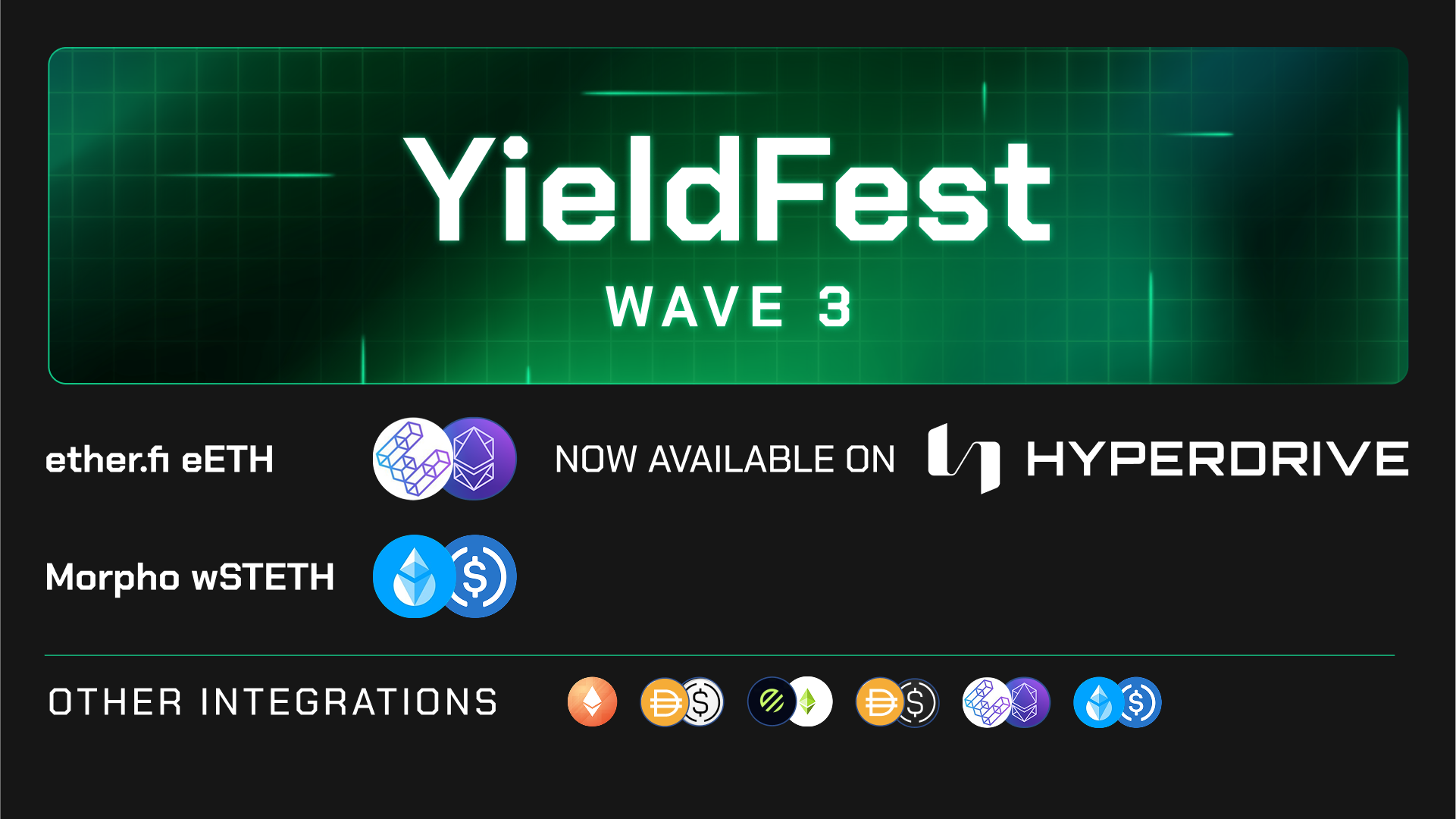Wave 3: ether.fi's eETH and Morpho's wSTETH/USDC Are Now Available as Yield Sources on Hyperdrive
We’ve got two more additions to celebrate: Morpho’s wSTETH/USDC and ether.fi’s eETH are available as yield sources on the Hyperdrive Protocol.

It’s another big week, and we’ve got more integrations to announce as YieldFest continues. We recently shared news about rETH and sUSDe/DAI, as well as ezETH and USDe/DAI. Now, we’ve got two more additions to celebrate: Morpho’s wSTETH/USDC and ether.fi’s eETH are available as yield sources on the Hyperdrive Protocol (developed by DELV and this instance operated and managed by the Element DAO).
“The introduction of wSTETH/USDC and eETH to Hyperdrive marks another important stage of innovation and growth,” said Charles St. Louis, CEO of DELV. “By bringing these assets into the Hyperdrive ecosystem, we’re providing users with more flexibility to build out their preferred strategies and pursue their financial goals. And we’re far from done—expect to see more yield integrations and expansion in the coming weeks and months.”
What is eETH?
eETH is a tokenized version of staked Ether (ETH) in the ether.fi protocol. When users stake their ETH through ether.fi, they receive eETH in return. eETH is designed with the aim of providing liquidity and flexibility. Users can employ eETH in lending, trading, or as collateral, while still generating yield from their staked Ether.
Integrating eETH adds more depth potential to the Hyperdrive AMM’s liquidity pools, providing access to new yield earning opportunities through Hyperdrive.
How to get started with eETH on a Hyperdrive pool
If you’re a liquidity provider, using eETH is simple. Here’s what you can do:
- Acquire eETH by converting your ETH to eETH through the ether.fi protocol, or acquire eETH through Uniswap, Matcha, CoW Swap, or other AMMs.
- Access the Hyperdrive app.
- Deposit your eETH by navigating to the LP tab.
- Earn yields through Hyperdrive's optimized liquidity pools.
And if you’re a trader, here’s how it all works:
- Acquire eETH by converting your ETH or LSTs to eETH through the ether.fi protocol, or acquire eETH through Uniswap, Matcha, CoW Swap, or other AMMs.
- Access the Hyperdrive app.
- Deposit eETH on Hyperdrive.
- Open a long position at a fixed rate or a short position at a variable rate.
What is wSTETH/USDC?
wSTETH is a tokenized version of stETH that has been wrapped to make it compatible with other DeFi protocols that require a standard ERC-20 token. Wrapping stETH into wSTETH essentially locks the stETH in a smart contract and issues an equivalent amount of wSTETH, which remains fixed in quantity.
In this integration with Hyperdrive, wSTETH will function as collateral for the Morpho market, and users will supply that market using USDC. Morpho is a trustless and efficient lending primitive that allows users to pursue their strategies to generate returns for staked assets and find opportunities for liquidity providers.
USDC is a stablecoin that’s pegged to the U.S. dollar. It’s designed to maintain a stable value and is widely used on exchanges. USDC operates as an ERC-20 token on the Ethereum blockchain, making it compatible with a wide range of dApps, and it’s popular among users who want to move in and out of potentially volatile assets without converting to fiat currency.
How to Get Started with wSTETH/USDC on a Hyperdrive pool
wSTETH will serve as the collateral for the Morpho market and the Hyperdrive Protocol supplies USDC to that market. That means you only need USDC to participate.
If you want to provide liquidity, here’s how it works:
- Acquire USDC by purchasing or borrowing.
- Access the Hyperdrive app.
- Deposit USDC on Hyperdrive by navigating to the LP tab.
- Earn yield with USDC staked on Hyperdrive. You’ll gain returns from staking and trading fees.
And if you’re a trader, here’s what you can do:
- Acquire USDC by purchasing or borrowing.
- Access the Hyperdrive app.
- Deposit USDC on Hyperdrive.
- Open a long position at a fixed rate or a short position at a variable rate.
YieldFest isn’t done yet, and we’ll have more exciting announcements about new yield sources soon, so stay tuned for updates.
Missed our earlier posts? Check out Part 1 and Part 2 to learn about the rETH, sUSDe/DAI, ezETH, and USDe/DAI integrations. Plus, take a look at our YieldFest kickoff announcement for more details (including our role as a non-exclusive service provider to the Element DAO).
Join the Party:
Note: This blog post is general in nature and for informational purposes only. It is not legal, tax, investment, financial or other advice, nor is it a comprehensive or complete statement of the matters discussed. It is not a recommendation of an investment strategy and should not be used as the basis of any investment decision.
All transactions and investments involve risk, and past performance does not guarantee future results. Certain complex strategies carry additional risk and are not appropriate for all users. As with any DeFi or crypto position, you may incur losses. You alone are responsible for evaluating the benefits and risks associated with any decision to use Hyperdrive and the risks or concerns with any underlying yield source.
Hyperdrive is not currently available in certain jurisdictions, such as the USA and the UK.

